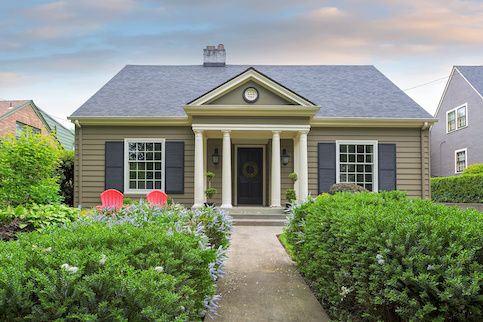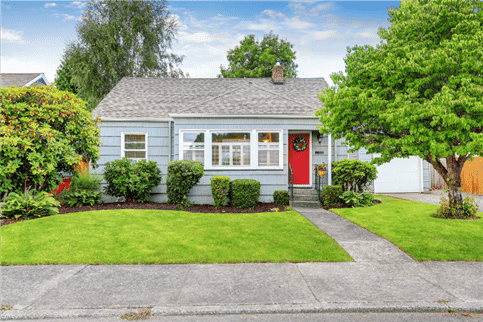First-time home buyers with a low or average income may have great loan options beyond a conventional mortgage, including FHA and USDA loans. Though both are government-backed loans, these programs have distinct differences, and each offers unique advantages.
USDA home loans can benefit middle- and lower-income borrowers looking to buy in somewhat rural areas, while FHA loans are ideal for those who’ve been able to save up a small down payment but lack the credit score to qualify for a decent interest rate on a conventional loan or qualify for a conventional loan at all.
Let’s explore the differences between USDA and FHA loans so you can determine which option – if either – makes sense for your situation and needs.
Find out if an FHA loan is right for you.
See rates, requirements and benefits.
USDA Vs. FHA Loans: Key Differences
As mentioned above, USDA loans and FHA loans are both government-backed loans, which means the loans are insured by the government against default. The similarities between these loans end there for the most part, however.
Backed by the U.S. Department of Agriculture (USDA), a USDA mortgage is designed to help low-to-middle-income individuals in relatively rural areas achieve homeownership at an affordable cost. Since the USDA insures these loans, home buyers can get a lower interest rate and more favorable loan terms than they might with some other types of home loans.
An FHA loan, meanwhile, is backed by the Federal Housing Administration (FHA) and intended for home buyers seeking an affordable loan for a primary residence despite having not-so-great credit and not a lot of money to put down. Though you don’t have to be a first-time home buyer to qualify, FHA loans are a popular choice among people purchasing their first house.
Depending on where you live and whether you’re buying a primary residence, you could qualify for one of these loans and enjoy a better interest rate and loan terms than you would have with a conventional loan. But what do you have to do to get an FHA or a USDA loan, and what sets them apart from each other?
Here’s a chart breaking down the various requirements of a USDA loan versus an FHA loan.
| USDA Loan | FHA Loan |
|---|---|---|
Minimum credit score | 640 | 580 (as low as 500 in some cases) |
Debt-to-income ratio (DTI) requirement | Up to 44% | Up to 57% in rare cases |
Loan limits | $377,600 in most places but varies by county | $472,030 for one-unit home in low-cost area; $1,089,300 for one-unit home in high-cost area |
Minimum down payment requirement | 0% | 3.5% |
Upfront fees | Guarantee fee of around 1% but that can vary | 1.75% mortgage insurance premium |
Location requirements | Yes | No |
Income limit | Borrowers not making more than 115% of their area’s median income | None |
Interest rates | Often dependent on market interest rate for mortgages; 4.125% for Single Family Housing Direct home loans | Dependent on market interest rate for mortgages |
Approval Process
The mortgage process for USDA and FHA loans, while following a generally similar series of steps, can differ in the length of time their approvals take, how the appraisal process works, and more.
See how their processes differ below.
USDA Loan Approval
To get approved for a USDA loan, you’ll need to provide all the usual documentation to get a loan, such as your credit score, proof of income and monthly debts. Before closing, you’ll also have to get an appraisal to certify your home is in a USDA-eligible area and is livable, connected to roads and sold at fair market value.
When getting approved for a USDA loan, keep in mind that the process to get your loan may take longer than getting an FHA mortgage. USDA loans are underwritten two times – once by your lender and then again by the USDA. Depending on how high your credit score is, your loan may go through either automatic or manual underwriting, the latter of which can take more time.
You can typically expect your loan to close in 30 – 45 days.
FHA Loan Approval
To get approved for an FHA loan, you’ll also have to provide your income, credit score, etc. Like a USDA loan, you’ll also be required to get an appraisal. With an FHA loan, however, you’ll need a specialized appraisal known as an FHA appraisal. The purpose of this examination of your home isn’t just to determine the home’s value, but it’s to make sure the house meets the health and safety standards of the U.S. Department of Housing and Urban Development.
You can expect your FHA loan to close in around 30 – 45 days as well, though it could take less than that depending on your situation.
Credit Score Eligibility
To qualify for a USDA loan, most lenders require a credit score of at least 640, though this number may vary depending on the lender.
To qualify for an FHA loan, a credit score of at least 580 is most often required. Some lenders will allow a credit score in the 500 – 579 range if you make at least a 10% down payment.
Debt-To-Income Ratio (DTI) Requirements
Your DTI is used by mortgage lenders to verify how much of your monthly income goes to your monthly debt payments, and it tells lenders whether you have room in your budget to afford the loan you’re seeking. To be eligible for a USDA loan, you’ll need a DTI of no higher than 44%.
FHA loans are a little more lenient in their DTI requirements, with some lenders allowing for a DTI as high as 57%. In many cases, though, you’ll need a DTI that’s significantly lower to receive loan approval.
Loan Limits
When taking out a mortgage, the 2023 USDA loan limit in most areas is $377,600, but this can be much higher in high-cost areas.
The lowest an FHA loan limit can be is 65% of the national conforming loan limit, which in 2023 is $726,200 for a one-unit property. So, for a single-unit home in a low-cost area, you could borrow as much as $472,030.
In high-cost areas, however, the FHA loan limit may be up to $1,089,300 for a one-unit home. As with USDA loans, FHA loan limits vary county by county, so the limit may be somewhere between these two numbers in many areas.
Down Payment Requirements And Closing Costs
When getting a USDA loan, no down payment is required. That means you could put 0% down and just pay closing costs, which are typically 3% – 6% of the purchase price.
As for FHA loans, you’ll need to make a down payment of at least 3.5% of your loan amount.
Mortgage Insurance
With USDA loans, you don’t pay private mortgage insurance (PMI) as you would on a conventional loan. Instead, you pay what’s known as a guarantee fee upfront at closing and then every month after for the full term of your loan. The guarantee fee you pay at closing is typically around 1% of your total loan amount, while the fee after that is 0.35% of your unpaid principal balance.
With FHA loans, you pay what’s known as a mortgage insurance premium (MIP) for the entire life of your loan unless you make a down payment of 10% or more, in which case you would be able to stop paying MIP after 11 years.
our MIP payment will be 0.15% – .075% of the base loan amount each year. You’ll also have to pay 1.75% of your loan amount in upfront MIP upfront at closing.
Location
If you’re getting a USDA loan, you can only purchase a home in a rural area deemed eligible by the USDA.
You can get an FHA loan anywhere, on the other hand, as long as the house meets HUD’s health and safety guidelines.
Income Requirements
Since USDA loans are intended for low- and moderate-income borrowers, these loans have income limits. Specifically, your adjusted gross income can’t be more than 115% of the median household income in your area.
FHA loans don’t carry income requirements, but you’ll have to prove you have a steady source of income by providing W-2s, pay stubs, etc. The FHA also states that borrowers shouldn’t spend more than 31% of their monthly income on housing costs In some cases, the housing ratio is higher. For example, if a loan went through automated underwriting (a refer/eligible loan), the housing ratio can be up to 37%.
Interest Rates
As government-backed loans, USDA and FHA loans both tend to offer a lower interest rate than you’ll get with a conventional loan. The rate you qualify for with both of these loan types will vary depending on how high rates are at the time you’re buying a house, how much you plan to borrow, your credit score and your down payment amount.
The interest rate on Single Family Housing Direct home loans is set by the government and sits at 4.125%. Direct loans are fixed-rate loans, so you’ll have that rate for the life of the loan.
See What You Qualify For
Buy A Home
Discover mortgage options that fit your unique financial needs.

Refinance
Refinance your mortgage to have more money for what matters.
Tap Into Equity
Use your home’s equity and unlock cash to achieve your goals.
Is A USDA Loan Or An FHA Loan Better For You?
If you’re interested in both USDA loans and FHA loans and could qualify for either, you may be wondering which would be a better fit for you. Let’s break down some of the reasons you might lean toward an FHA or USDA loan.
When An FHA Loan Is Better
FHA loans are popular with first-time home buyers for several reasons. At the same time, though, FHA loans come with some downsides. Here are some notable pros and cons of using an FHA loan.
FHA Loan Pros | FHA Loan Cons |
|---|---|
A lenient credit score requirement | Some down payment being required (3.5% minimum) |
Having a relatively low interest rate | Upfront and annual MIP costs |
Availability for multifamily homes | Loan limits based on location |
Now let’s take a deeper dive into a couple of reasons you might consider an FHA loan.
You Live In An Urban Or Suburban Area
While both USDA and FHA loans have their perks, USDA loans have some clear limitations. Since they’re only available to buyers in somewhat rural areas, they severely limit where you could buy a house. If you want to buy a home in a suburban or urban area, an FHA loan can give you an attractive interest rate without restricting you to a rural area.
You Want Looser Underwriting Requirements
If you don’t want to deal with restrictions on where you can live or you don’t want to face a lengthier process in getting approved for a loan and getting to the closing table, an FHA loan is more suitable than a USDA loan.
When A USDA Loan Is Better
USDA loans, while designed for only select borrowers, do have their perks. Keep in mind the following pros and cons of USDA loans when making your decision.
USDA Loan Pros | USDA Loan Cons |
|---|---|
No down payment requirement | A higher credit score being required |
No mortgage insurance, technically-speaking | Availability for single-family, rural homes only |
The ability to finance 100% of a home’s appraised value | Eligibility being limited to borrowers who make at or below an income limit |
Let’s take a closer look at a couple of reasons you might choose a USDA loan over an FHA loan.
You Live In A USDA-Qualified Area
If you live in a rural area or plan to live in a rural area, a USDA loan may be a perfect fit for you. This option aims to help rural buyers achieve homeownership more affordably. If you fit that category, you can reap the benefits and avoid some of the costs and complications of other loans.
You Want No-Money-Down Financing
One of the biggest benefits of getting a USDA loan is that you don’t have to make a down payment of any size. Only VA loans and USDA loans offer this benefit. The ability to buy a house with no down payment is a huge advantage that can make homeownership much more affordable for many people.
FHA loans, while more affordable than conventional loans in some ways, do still require a down payment. If you qualify for a USDA loan, consider whether the upfront savings that come with having no down payment would be a big help to you.
FAQs: The Difference Between FHA And USDA Loans
Still thinking it over? Check out the answers to these frequently asked questions about the differences between FHA and USDA loans.
Is the USDA stricter than the FHA?
USDA loans require a higher credit score than FHA loans, and they also carry geographical restrictions for where you can buy a qualifying home. USDA loans also have income limits for prospective homeowners, while FHA loans impose no such limits.
What is one advantage a USDA loan has over an FHA loan?
The absence of a down payment requirement is a major advantage USDA loans over FHA loans, which carry a minimum down payment of 3.5%. Avoiding a down payment can save a home buyer a large amount of money upfront.
Can I take PMI off a USDA loan?
USDA loans don’t have traditional mortgage insurance like conventional loans but instead require what’s known as an upfront and annual guarantee fee. The annual guarantee fee is paid monthly over the life of the loan and can’t be removed.
The Bottom Line
USDA and FHA loans are government-backed loan options that can be ideal for first-time and low- to medium-income home buyers. Both programs offer plenty of benefits, which often include achieving homeownership sooner and more affordably than you otherwise could.
Find out if an FHA loan is right for you.
See rates, requirements and benefits.

Sidney Richardson
Sidney Richardson is a writer who specializes in real estate, homeownership and personal finance content. She holds a bachelor's degree in journalism with a minor in advertising from Oakland University.












